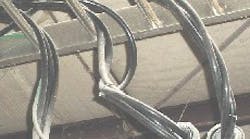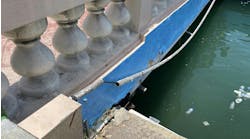A reader submitted these pictures of a chiller served by a feeder that consists of three sets of 350 kcmil THHN conductors that originate at an 800A breaker in a switchgear room, extending about 600 feet to the side of the building. The conductors terminate at the outdoor chiller enclosure main breaker. Most of the feeder conductor is routed in a cable tray, the last 40 feet of which is in rigid metal conduit (Photo 1). There’s also a short section of liquidtight flexible metal conduit located outdoors.
By the submitter’s calculation, the voltage drop for this circuit (with a load of 300A) should only be about 3.9V. However, he measured a voltage drop in the conductor of 15V. The excessive voltage drop is due to higher impedance of the circuit.
Three raceways carry the three sets of conductors (Photo 2). However, all the “phase A” conductors are in one raceway, all the “phase B” conductors are together, and all the “phase C “ conductors are together. Along with excessive voltage drop and unbalanced current between phases, the most dramatic consequence observed is induction heating of the metal conduits (Photo 3).
See 310.4 (no Exceptions apply) for the rules of installation of conductors in parallel:
“Aluminum, copper-clad aluminum, or copper conductors of size 1/0 AWG and larger, comprising each phase, neutral, or grounded circuit conductor, shall be permitted to be connected in parallel (electrically joined at both ends to form a single conductor).
“The paralleled conductors in each phase, neutral, or grounded circuit conductor shall:
“(1) Be the same length
(2) Have the same conductor material
(3) Be the same size in circular mil area
(4) Have the same insulation type
(5) Be terminated in the same manner
“Where run in separate raceways or cables, the raceways or cables shall have the same physical characteristics. Conductors of one phase, neutral, or grounded circuit conductor shall not be required to have the same physical characteristics as those of another phase, neutral, or grounded circuit conductor to achieve balance.
“FPN: Differences in inductive reactance and unequal division of current can be minimized by choice of materials, methods of construction, and orientation of conductors.
“Where equipment-grounding conductors are used with conductors in parallel, they shall comply with the requirements of this section except that they shall be sized in accordance with 250.122.
“Conductors installed in parallel shall comply with the provisions of 310.15(B)(2)(a).”
The submitter also noted many other violations, including:
• The raceways were not bonded to the enclosure.
• The equipment grounding conductor was missing from two of the three raceways.
• The small pump unit sub-feeder conductors tapped onto the line side of breaker aren’t protected against overcurrent.
• The equipment grounding conductor appears smaller than that required by Table 250.122.
• The conduits aren’t bonded to cable tray.
• The phase conductors aren’t grouped together in cable tray.
• The equipment grounding conductor isn’t grouped together with phase conductors.



